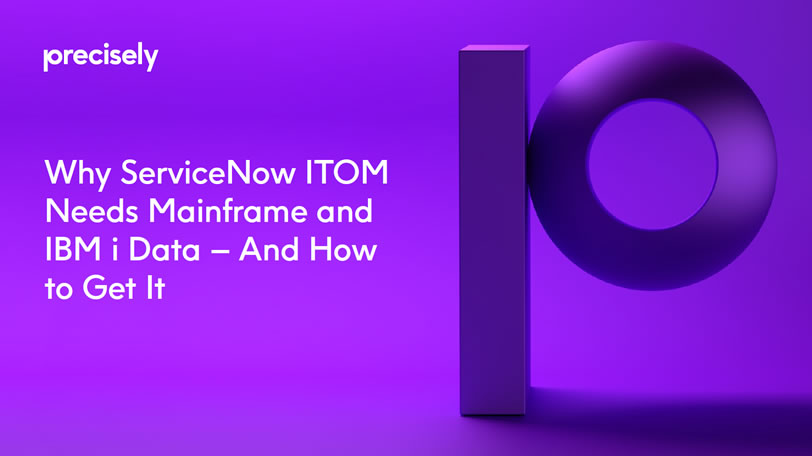eBook
Why ServiceNow ITOM Needs Mainframe and IBM i Data - And How To Get It
Read this eBook to learn how to seamlessly integrate Mainframe and IBM i data into your ServiceNow ITOM platform – ensuring greater success by delivering fully-integrated enterprise-wide visibility.
Introduction
IT Operations Management (ITOM) and IT Service Management (ITSM) provide a single system of record for IT with visibility into infrastructure and services. This leads to more control of the environment and better decision making. Such platforms, such as ServiceNow, are being broadly adopted by forward-looking enterprises to automate discovery, asset management, event management, and other vital functions.
But these platforms have a huge blind spot that inhibits their value: out of the box, they don’t include IBM mainframe and IBM i systems. A great many organizations continue to deploy IBM i systems and IBM mainframes. Banks, healthcare, financial services, government and other verticals rely upon these platforms to run mission-critical applications and databases. Most ITOM systems do not support the integration of this data with other enterprise systems.


What tends to happen is that those managing operations either leave the mainframe/IBM i to another team or have evolved complicated workarounds in an attempt to gain a more complete view of the enterprise. In some cases, they call their local mainframe/IBM i guru to ask what systems and applications are operating. In other cases, there are two different IT analytics platforms: one for mainframe/IBM i and one for the rest of the enterprise. Alternatively, spreadsheets and Visio diagrams are referred to. But these documents quickly become outdated.
Failure to consolidate mainframe and IBM i data in ITOM with other enterprise systems can have serious consequences. Sluggish application behavior may be incorrectly blamed on the network when the real fault lies on the mainframe/IBM i side, for example. What isn’t understood well in IT is how many enterprise processes interface with IBM i and mainframe services. As a result, troubleshooting efforts may be thwarted, upgrade efforts may not have the desired impact and event management actions may be incorrectly targeted. This blind spot inevitably leads to bad decisions, downtime and lowered productivity.
By unifying this IBM i and IBM mainframe information with enterprise systems data, IT can leverage its investment into ITOM platforms to discover all applications, processes, workflows and hardware operating on the network, automate tasks and carry out event management more effectively.
Why ITOM is Important:
Organizations rely on ITOM platforms to monitor IT operations, manage services throughout the enterprise, put together a single system of record for all IT assets, automate tasks and more. ITOM is all about managing the provisioning, capacity, performance, and availability of IT infrastructure. ITOM systems provide automation that discovers, monitors and controls the way IT manages the enterprise. This encompasses both on-premise and cloud resources such as applications, services, storage, hardware and networking. Effectively done, ITOM ensures availability, improves efficiency and heightens the performance of processes and services.
ServiceNow Discovery, for example, provides IT with visibility into the IT infrastructure as it exists and keeps track of how it changes. It helps IT to discover physical and virtual devices such as laptops, desktops, servers, switches, routers, storage, and applications, as well as the dependent relationships between them. Whether on premises or in the cloud, it identifies applications, cloud resources, container clusters and hardware, and offers dependency views that depict how IT resources relate to one another.
Based on this firm foundation, IT gains a robust mechanism for change management. By populating and updating the Configuration Management Database (CMDB) automatically, it becomes much easier to understand an organization’s IT environment, particularly in the areas of service impact analysis, asset management, and compliance and configuration management.
However, without including the traditional IBM systems in their IT Operations strategy, the value of ITOM is curtailed. Many organizations, particularly banks, insurers, retailers, telco and healthcare providers continue to rely on IBM z/OS and IBM i systems for mission-critical business processes. It is estimated that up to 80% of corporate data in these companies touches these systems. By failing to include the data from traditional IBM systems the organization is forced to operate with an incomplete picture. This can lead to erroneous conclusions, bad decisions and extended downtime. These companies need a comprehensive discovery process that spans both enterprise systems and the mainframe and IBM i environments to facilitate effective ITOM and event management.
Discovery
Discovery is the heart of ITOM. The management of provisioning, capacity, performance, and availability of IT infrastructure will be flawed without a discovery function that accurately populates the CMDB and keeps it automatically updated. Current discovery applications, and those built into ITOM platforms, carry out this function diligently for most systems. They seek out every app, device, node, workflow and dependency throughout the enterprise.
By failing to discover mainframe/IBM i data, however, they fall short. They miss changes to IBM i and z/OS systems, don’t detect logical partitions (LPARs) and other storage from their discovery activities. Some may discount the importance of consolidating enterprise and mainframe/IBM i data in one central CMDB. But failure to do so puts the organization at risk.
Let’s look at an actual example: In large companies, ATM transactions typically take a trip through the mainframe or IBM i systems for various reasons. This might be to check an account balance or detect potential fraudulent activity. If the help desk is dealing with a problem with a credit card or financial transaction it will struggle to resolve it if it doesn’t deal with complete ITOM data. Those troubleshooting the issue might get in touch with the applications team. After a couple of hours without resolution, they may then call the z/OS team who review the IBM DB2 performance monitor. Things look fine to them as it’s holding a performance level of 10,000 transactions a second. A day might be wasted trying to come to terms with what went wrong on that one transaction.
Additional troubleshooting might uncover from the CICS transaction log that the transaction was rejected due to a table being locked out, perhaps due to a batch job running on that same table or an app that had a bad password entered incorrectly three times. Due to a possible security breach, the table was locked. To debug the issue, you would have to reset password that hung up the ATM transaction.
Organizations with top-of-the-line ITOM systems in place, as well as veterans running mainframe or IBM i systems, may believe they can solve any issues that might crop up. Inevitably, the presence of information
siloes and an incomplete CMDB greatly inhibit the resolution of problems. What is lacking is a single end-to-end repository where analysis can be accomplished in a holistic manner. Only by having all discovery data in one place does it become easy to disentangle the complexity of dependencies and zero in on root causes.
“Only by having all discovery data in one place does it become easy to disentangle the complexity of dependencies and zero in on root causes.”

Discovery for IBM Mainframe and IBM i with Ironstream
Discovery on the mainframe and IBM i can be challenging. It deals with different data types such as packed decimal, binary and log data from IBM’s Systems Management Facility (SMF). Integration, data conversion and the general complexity get in the way of the discovery process. Manual logs, spreadsheets and Visio charts aren’t enough.
That’s why enterprises turn to Ironstream, Precisely’s innovative machine data integration software. Ironstream provides ITOM platforms such as ServiceNow and Micro Focus with full discovery capabilities for mainframe and IBM i systems. This assists traditional ITOM in populating and updating the CMDB, making it easy to understand an organization’s IT environment. By seamlessly integrating IBM i and z/OS data into powerful ITOM platforms, organizations can automate tasks and provide insights previously not possible. This fills the blind spot in enterprise ITOM.
Ironstream takes care of the discovery process for the entire mainframe and IBM i environment. Changes, new LPARs and added storage devices are automatically updated and transmitted to the ServiceNow or other ITOM CMDB. Service management, asset management, compliance, troubleshooting and configuration management can be conducted with confidence as the latest data is available on what is out there and the various dependencies.
Ironstream consumes negligible system resources and the discovery process is flexible and straightforward. IT can set specific auto-discovery parameters based on business needs. The system compiles z/OS and IBM i data such as storage, memory, LPARs, CPUs, network connectivity, installed software, selected system values, subsystems, active jobs, job queues, completed jobs, output queues, libraries and program objects.
In addition, Ironstream records specialized mainframe data such as:
- Db2 – DDF, DSG, databases, table spaces and deep configuration data
- CICS – regions, transactions, programs
- IMS – regions, databases, transactions, programs
- MQ – managers, channels, queues
As a result of the easy set up and administration, there is a greatly reduced need to rely on input from mainframe or IBM i experts. This increases agility, speeds the resolution process and enhances decision-making.
“Bringing the IBM mainframe environment into our ServiceNow infrastructure provides us the deep insight necessary to take our business to the next level,” said the Service Management Manager of a major insurance provider.


Event Management
Event management is another key ITOM function. It is concerned with the monitoring of the many events that occur through the IT infrastructure. These systems detect anomalous conditions and escalate exceptions to what is considered normal operation. Detected events are analyzed to determine actions to be taken, if any. Event management seeks to extract meaning out of events like a server going idle or a maintenance script running. This facilitates service assurance, reporting service improvement and other functions.
As is the case with Discovery, platforms like ServiceNow also omit information from mainframe and IBM i environments for event management. Any analysis of events is not correlated with other events happening within mainframe or IBM i systems. Serious problems, therefore, may not be spotted and corrective actions might be initiated against the wrong target.
Without visibility into the entire application chain, event management activities may be ineffective. Unsuspected dependencies can impact these traditional IBM systems. Multi-tier applications may have processes that weave through mainframe or IBM i applications and databases. Problems in mainframe applications such as CICS can delay transaction processing. Queuing issues in IBM MQ middleware can cause data bottlenecks between apps and servers. With it costing $10,000 or more for every minute of revenue lost to downtime in many organizations, it is incumbent on IT to get in front of problems by being able to consider mainframe and IBM i events as part of a collective event management process.
Event Management for IBM Mainframe and IBM i with Ironstream
Event management systems help companies manage their IT environments across traditional data centers, private and public clouds, client computers and other devices. As an application that is tightly integrated with ITOM solutions, Precisely provides IT operations staff with the ability to take immediate corrective action based upon centrally deployed policies for important messages or events.
Ironstream seamlessly integrates the event and system performance data from IBM mainframe and IBM i systems with IT Operations platforms such as ServiceNow. By integrating the data from these traditional IBM systems with the data from all the other systems in the IT infrastructure, IT teams have a single, complete view of their entire event management environment. This helps them simplify training and streamline operations.


Using Ironstream to forward event data from these traditional, mission-critical IBM systems to modern event management platforms provides IT with insight they would not have without the benefits of Ironstream. For multi-tiered applications that span from mobile devices to enterprise middleware to transaction processing systems like mainframes and IBM i, it can be difficult to troubleshoot event and performance issues without having data from all the systems integrated into a single analytics platform. With the consolidated view, things like slow ATM transactions and other events can be traced to the root cause – whether on the mainframe or elsewhere. Issues in CICS transaction logs, batch jobs slowing other processes and tables locked due to potential security breaches are much more easily managed. IT can zero in on only the most important issues to isolate the underlying problem. The siloes that exist between enterprise systems and the traditional IBM systems, and even within different mainframe groups, are broken down and mainframe and IBM i become part of a complete end-to-end event management solution.
The Problem with Workarounds
Faced with a gaping chasm of data between mainframe/IBM i and other enterprise systems, IT sometimes relies on various workarounds. In some cases, spreadsheets or Visio charts are created as a substitute for automated discovery of IBM i and z/OS data. Such approaches are time consuming, subject to human error and distract personnel from vital tasks. As the resulting inventories are generally only conducted once or twice a year, they quickly become obsolete.
Another workaround concerns piecemeal tools that provide some of the data required in discovery and event management. Alternatively, IT calls someone on the mainframe or IBM i team. They depend upon an in-house expert to tell them what might be going on. But what if that person is ill, has gone to lunch or left the company unreplaced the week before? All it takes is a retirement or a personnel shift and suddenly no one knows anything. The bottom line is that reliance on manual approaches or memory is a sure route to problems, unexpected surprises, downtime and eventual catastrophe.
To make matters worse, IT may contend with multiple groups within the mainframe/IBM i organization. There can be one group for Db2 and another for CICS. Each may maintain its own repository, but they are not necessarily in the same format and may not be updated on the same frequency. Thus, there can often be a lack of consolidated mainframe and IBM i information.
Trying to solve this problem with these manual, ad-hoc approaches almost always fails. They don’t address the underlying problem. In order to be efficient and reliable, ITOM demands a unified view of the entire computing infrastructure for discovery and event management.

Summary
ITOM has been implemented by many companies as a way to improve infrastructure visibility, gain tighter control over the IT environment, optimize performance and minimize downtime. However, ITOM solutions have a major blind spot.
Without the incorporation of IBM mainframe and IBM i data, the organization becomes vulnerable. It is forced to operate on incomplete insights that lead to longer response times, dissatisfied customers and downtime.
Ironstream offers an easy path to end-to-end discovery and event management across all systems. It seamlessly integrates and consolidates IBM i and z/OS data with powerful ITOM and event management platforms running on other enterprise systems. By eliminating the siloes that exist between ITOM and the mainframe/IBM i, the discovery and event management functions can now be carried out effectively for the first time.